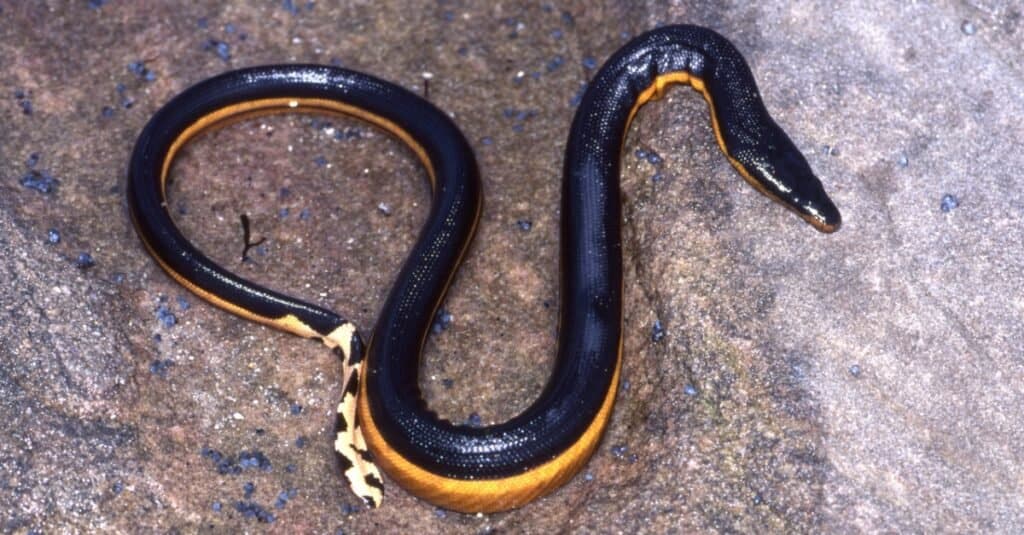Key Points:
- No snake species is native to Hawaii; all are invasive.
- 7 snake species are found on the islands.
- Bringing snakes to the state or owning them is considered a felony and may result in jail time or a hefty fine.

Are There Snakes in Hawaii?
Are there snakes in Hawaii? The answer is yes, but there shouldn’t be, considering none of the terrestrial snakes present are native to any of the islands of the adored archipelago. In fact, possessing a snake in Hawaii is considered a crime and can rack up a $200,000 fine or three years in prison. The Hawaiian Department of Agriculture has been successfully cracking down on unwanted serpents over the past few decades.
The ecosystem of Hawaii is extremely delicate, so introducing a non-native species threatens the safety of the native wildlife. Snakes have no natural predators on the island, so they are easily able to out-compete existing animals and even diminish their populations. They also pose a high threat to endangered native birds, preying on them and their eggs.
While efforts to eradicate snakes are being made, several species are found in the state today. Below, we have gathered a list of snakes that have lived or currently live in Hawaii.

Hawaii is so isolated that plants and animals that have evolved on the islands had to travel more than 2,000 miles to get there.
©Bardocz Peter/Shutterstock.com
A Snakeless State
Hawaii sits 2,000 miles to the southwest of the continental U.S. and began forming in isolation 30-plus million years ago in one of the most isolated areas in the world. Being so isolated, the plants and animals that have reached and evolved on the islands had to travel more than 2,000 miles from the nearest continent or had to ride the winds from other far-flung Pacific islands.
Given this isolation, you can see why there are no native snakes in Hawaii. The journey is simply too vast for snakes to survive and then begin a thriving colony on the island. As with many other Pacific islands, the freedom from massive numbers of rodents and snakes allowed ecosystems to form that are unprepared for these invasive predators. Thus, if snakes are able to take hold in Hawaii they could cause significant losses to species that are native to Hawaii.
7 Snakes in Hawaii
As a reminder, none of these snakes are native to Hawaii (we’ve included a sea snake as well that doesn’t live on land). However, each has been reported on the islands in the past. Most of the snakes in the list below have been contained after reports of them reaching the islands. However, others like the Brahminy blind snake are now in Hawaii in significant numbers. Luckily, this specific species is notably harmless.
Brahminy Blind Snake

Brahminy blind snakes
are harmless, but now inhabit Hawaii in significant populations.
©Patrick K. Campbell/Shutterstock.com
Even though this snake wasn’t originally indigenous to Hawaii, they’ve been here so long that many consider it a native species. These creatures are one of the smallest snake species in the world at 6 inches in length and have slim bodies, so you would be forgiven for mistaking one for an earthworm. They feed on ants and termites, which some people might appreciate.
A more interesting fact is that every one of them is female. This species is parthenogenetic, which means they reproduce by laying eggs that hatch without fertilization. That means that it only takes one snake to produce countless generations!
While this would pose a problem in removing them, there is no need for that in this case. Since the brahminy blind snake is nonvenomous and has little impact on the ecosystem, they are basically harmless.
Ball Python

Ball pythons are a popular pet species that have been spotted in Hawaii.
©Krisda Ponchaipulltawee/Shutterstock.com
One of the more recognizable snake species, thanks to its diamond-like pattern and larger head, the ball python is a common pet in the rest of the United States. They may be born small, but they can grow up to six feet in length on a healthy diet of small mammals and birds, which is exactly why they would throw the Hawaiian ecosystem into chaos were they ever to be let loose.
Despite strict regulations, there have been three reports of ball python sightings in the last seven years. For instance, in 2020, one 4-footer was spotted in Kahalu’u Forest on Oahu Island by a hunter, who turned it over to the humane society.
Even though ball pythons are nonvenomous, they are still fierce predators who constrict their prey, cutting off air and blood flow and sometimes breaking bones, before swallowing them whole. They may be safe in a human home, but they are too much for Hawaii to handle.
Boa Constrictor

There have been several boa constrictors sighted in Hawaii across the past decade.
©reptiles4all/Shutterstock.com
Another common pet, the boa, grows far larger than its fellow constrictor, the ball python. Unfortunately, there have been far more boa sightings in Hawaii. In 2011, two were spotted on a farm, one of which was 9 feet long! There were two separate incidents in 2013: a 3-footer was sighted at a Honolulu crosswalk, and a 5-footer was run over on the Pali Highway. In 2015, the HDOA confiscated a 7-foot boa in Nuuanu.
While some of these snakes may simply be escaped pets, they may also come from a black market specializing in exotic pets. Due to its larger size, the boa constrictor is considered more exotic than the ball python, which may explain why more have been seen. If the ball python is too dangerous for Hawaiian wildlife, one can imagine the sheer havoc the boa could wreak.
Garter Snake

Garter snakes have three stripes that run the length of its body.
©iStock.com/randimal
How did this iconic mainland snake get to Hawaii? Well, there are two incidents, both involving Christmas trees. First, in 2004, a supermarket in Hawaii received a shipment from a company in Oregon. Unfortunately, this shipment included not only trees and other festive items, but also a 13-inch garter. After that, the islands remained garter-free until 2020, when another Christmas tree shipment included a garter stowaway, though this one died in transit.
This snake is quite common throughout the wilds of the United States and in the homes of some pet owners. Hawaii, of course, is an exception. Though there are several different kinds of garter, they all share a common trait: the long, narrow stripe on top of its body, usually yellow or white in color. Despite being a good pet in most cases, they are actually slightly venomous, just not to humans, as their venom is rather weak and lacking in quantity.
That doesn’t mean you want to get bitten by one, as their bites may still cause swelling. Furthermore, even though their size only allows them to feed on small critters, their palette is quite expansive, including various bugs, fish, and amphibians. Thus, these Christmas miracles could have become Christmas catastrophes if they had settled in Hawaii.
Corn Snake

There has been one corn snake spotted in Hawaii in 2019.
©Enrique Ramos/Shutterstock.com
Another nonvenomous snake, the corn snake, can get quite large and is known to reach a whopping 6 feet. Yet, despite its comparatively large size, it isn’t threatening to humans and sticks to the standard snake diet of birds, their eggs, and small mammals. In other states, that wouldn’t be a problem, but in Hawaii, it would be a dangerous invasive predator.
Corn snakes are seldom seen in Hawaii, as the only ever reported sighting was in 2019. It was found in someone’s backyard, and its origins are a total mystery. It was swiftly reported to the HDOA, and there have been no sightings since. However, the fact that it popped up out of nowhere is concerning.
As nocturnal animals, they are only active at night, so while another may be lurking about in the wild, this is very unlikely. If you see their orange bodies and the red spots they bear, there’s no need to worry about your safety, but please report it to the proper authorities.
Venomous Snakes in Hawaii
Hawaii has a couple of venomous snakes to be aware of. The brown tree snake is especially problematic as it previously wiped out much of Guam’s native species after being introduced. Thankfully, to date the only brown tree snakes spotted in the state are for training purposes.
Yellow-bellied snakes are the closest thing Hawaii has to a “native” snake, but they’re an aquatic species that are rarely found near the island’s shores.
Brown Tree Snake

Brown tree snakes stow away on cargo vessels and aircraft.
©Janelle Lugge/Shutterstock.com
Although these snakes are only native to some islands between the Indian and Pacific oceans, they somehow continue to make their way across the Pacific by stowing away on cargo vessels and aircraft. Like other snakes, they eat small mammals and birds, but growing brown tree snakes have been known to eat up to 70% of their body weight per day. On top of that, they are venomous to humans and have been known to bite.
If one needs proof of how dangerous these snakes are to an isolated ecosystem, one only has to look at Guam, which has lost much of its native species to extinction after the brown tree snake found its way there in the 1940s. It multiplied over the decades, and nowadays, it sits atop the food chain of Guam with no natural predators.
This is why the HDOA is diligent in keeping them out of Hawaii and eradicating them when spotted. As of today, the only known brown tree snakes in Hawaii are a quartet imported for training dogs to help root them out. That being said, these snakes are quite sly and adventurous, so staying alert on your travels wouldn’t be the worst idea.
Yellow-Bellied Sea Snake

The yellow-bellied sea snake is found in all tropical oceanic waters except for the Atlantic Ocean.
©Ken Griffiths/Shutterstock.com
This is the closest thing to a native Hawaiian snake, even though it rarely swims onto the shore. However, they are far more common on the beaches of North America, so the prospect of one finding its way to Hawaii isn’t so farfetched. The yellow-bellied sea snake can be identified by its yellow belly (of course), the black stripe on its back, and its black-and-yellow-spotted tail.
Even though this sea snake is venomous, there is no record of one having attacked anyone in Hawaii. In fact, they tend to steer clear of humans, lurking under rocks to hide from predators. They are also quite slow to bite, and if successful, permanent damage can be avoided if treated quickly. However, they are potentially fatal, so you should still try to avoid them and get treatment immediately if bitten.
Snakes Of The Islands
It’s easy to guess why the HDOA is so strict in keeping snakes out of Hawaii. When any ecosystem is well-established, the introduction of a new predator can wreak havoc on the species that live there.
This is especially true for an island like those that makeup Hawaii. Since they are isolated, they have smaller ecosystems due to their size and sometimes have species found nowhere else in the world. It’s no wonder that the people that live there wish to protect the miracle they call home.
Even though snake lovers may be disappointed in the lack of small slinkers among the unique wildlife of Hawaii, it’s for the sake of said wildlife that such restrictions are in place. Furthermore, it’s one less thing for hikers to worry about! That being said, keep your eyes open; you may spot one of these snakes or even one we haven’t mentioned!
In conclusion, snakes are awesome, but keep them where they belong… which isn’t in Hawaii!
Anti-Snake Legislation in Hawaii
Given the ability of these reptiles to reproduce prolifically and set upon native species with a will – not to mention the absence of any natural predators – the state government is understandably intolerant of their presence.
Hence the natural paradise may not prove so idyllic for fans and enthusiasts of the controversial slithering reptile. Especially since owning snakes is illegal in Hawaii and the cost of potentially disrupting the ecosystem in this regard comes with a hefty $200,000 fine and a three-year sentence.
However, the government has also generously provided a loophole for any perspiring snake owners living in perpetual fear of an observant neighbor dialing the pest hotline and reporting them to the authorities.
Thanks to the state’s amnesty program, they can deliver up their reptilian charges, themselves, at any HDOA or rescue office and make it home without having to pay that astronomical fine or endure a nerve-wracking questioning session at a police station. So, does Hawaii have snakes? Yes, but many consider it to be an unfortunate addition to paradise.
Summary of Snakes in Hawaii
| Venomous | Non-Venomous |
|---|---|
| Brown Tree Snake Yellow-bellied Sea Snake | Brahminy Blind Snake Ball Python Boa Constrictor Garter Snake Corn Snake |
Up Next…
- 8 Extinct Hawaiian Birds: Hawaii is home to some of the most unique and beautiful birds on the planet – discover which are now extinct.
- Discover 5 Islands Where Invasive Snakes Caused Extinction of Wildlife: Hawaii is working hard to make sure invasive snakes don’t cause extinction – find out which islands were not successful.
- Discover 4 Animals Invading the United States: Snakes aren’t the only invasive animals! Learn about four animals that are invading the United States.
The photo featured at the top of this post is ©
Discover the "Monster" Snake 5X Bigger than an Anaconda
Every day A-Z Animals sends out some of the most incredible facts in the world from our free newsletter. Want to discover the 10 most beautiful snakes in the world, a "snake island" where you're never more than 3 feet from danger, or a "monster" snake 5X larger than an anaconda? Then sign up right now and you'll start receiving our daily newsletter absolutely free.
Thank you for reading! Have some feedback for us? Contact the AZ Animals editorial team.







